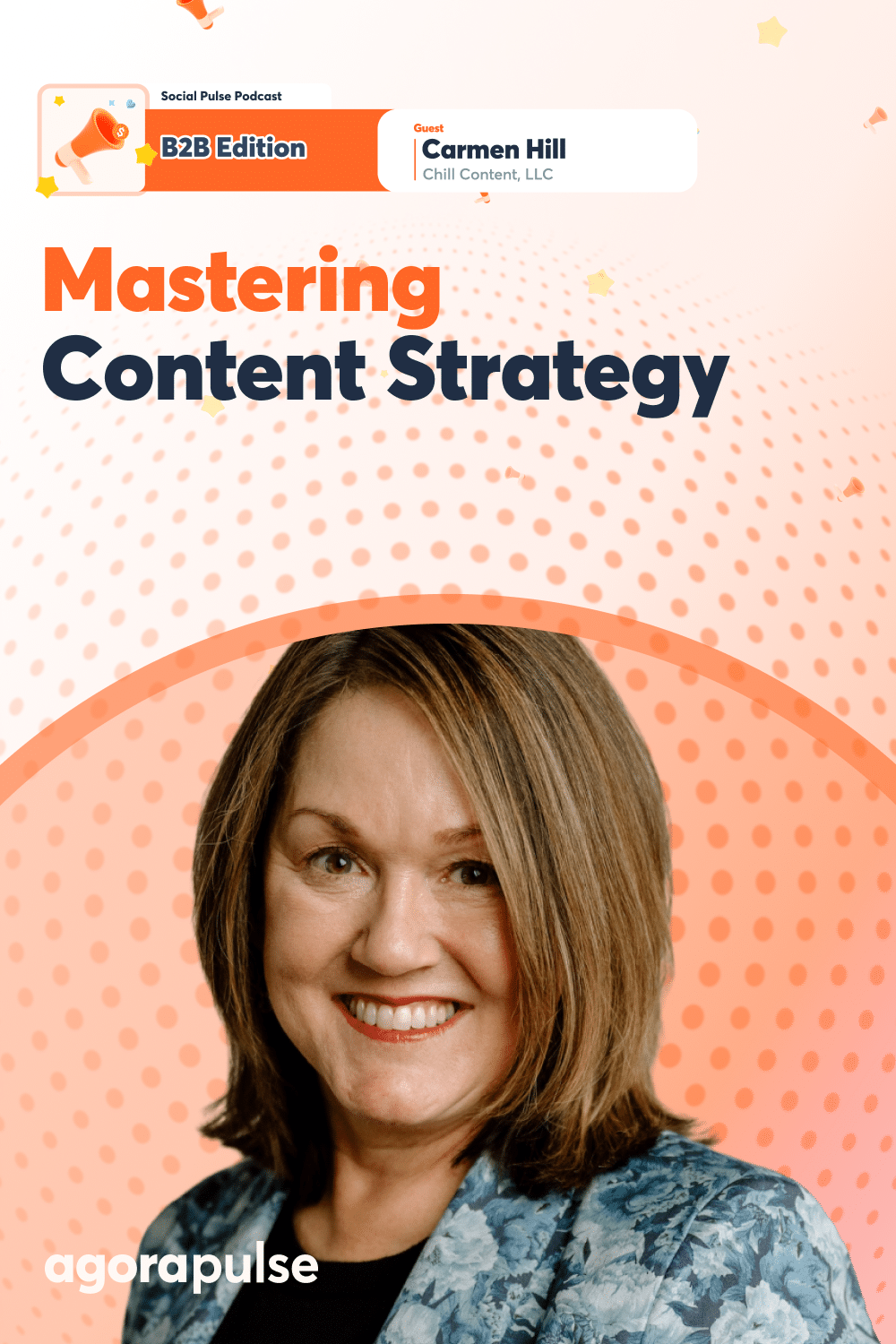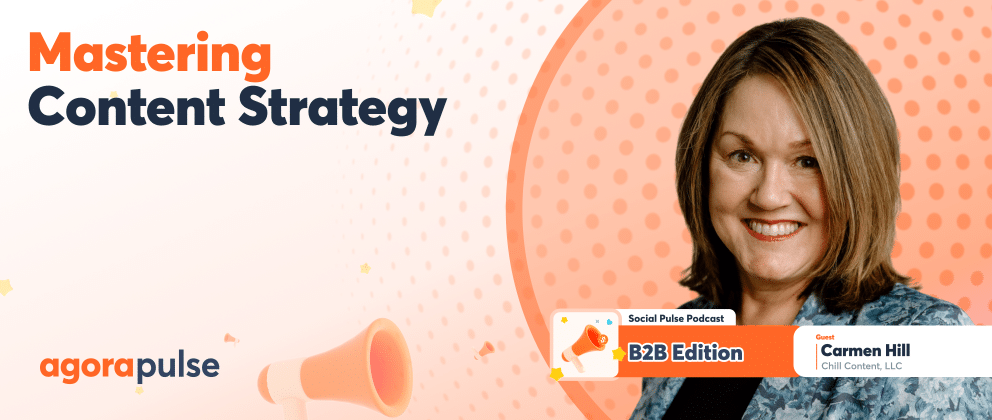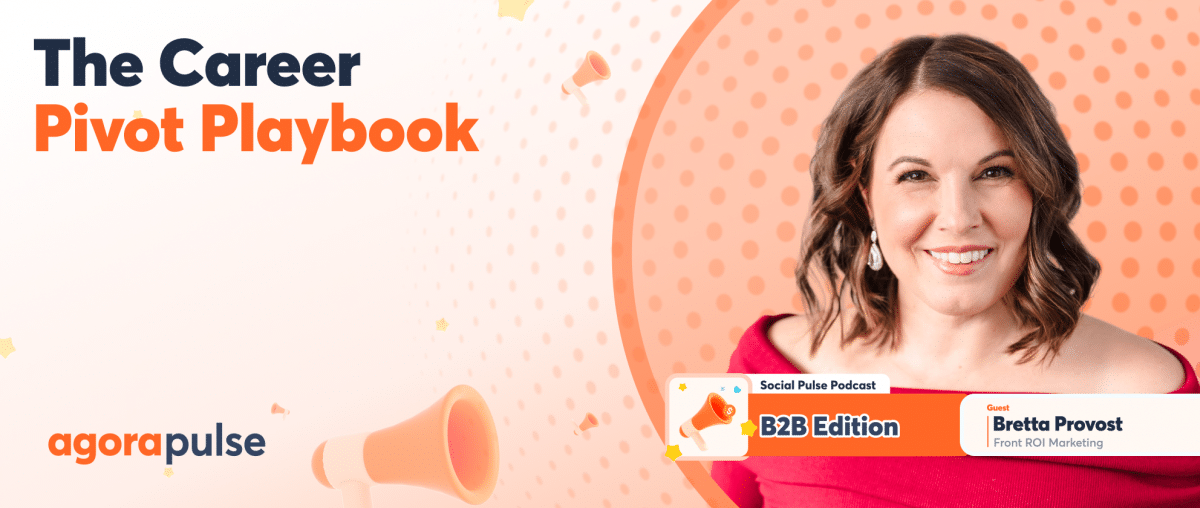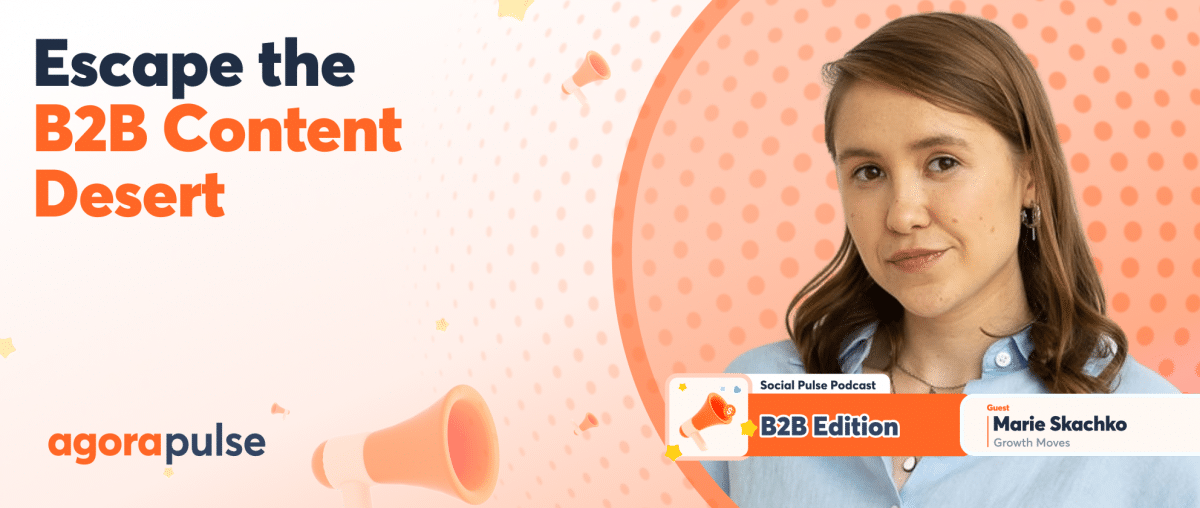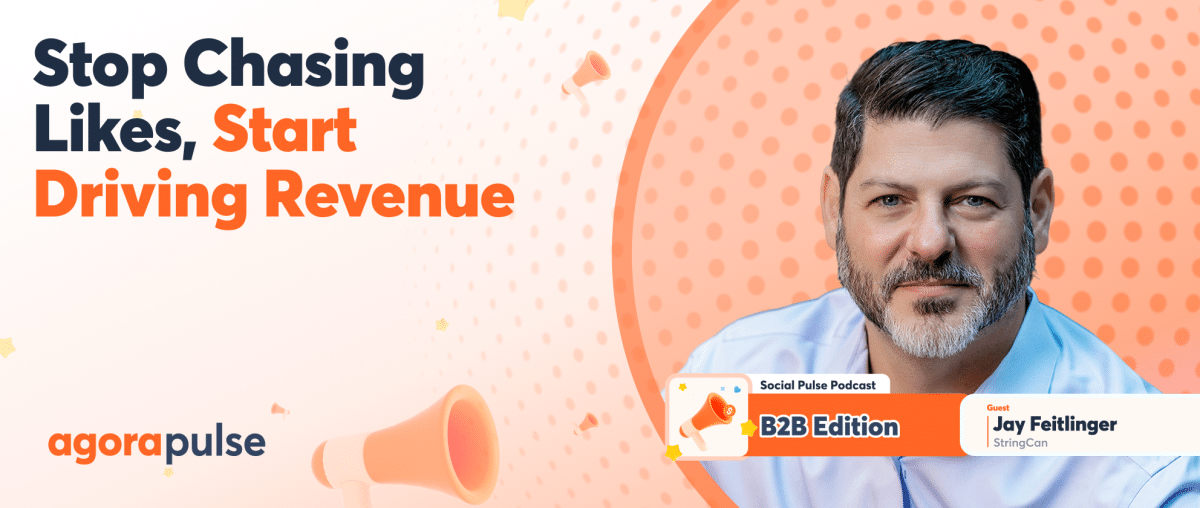In today’s landscape, marketers are investing countless hours and resources into content creation, yet many struggle to see the impact they know their content could have.
What if the problem isn’t the quality of your content but rather the framework or use to plan and execute your content strategy? What if there was a way to ensure every piece of content you create serves multiple purposes and reaches its full potential?
These are the questions that might keep content marketers like myself and you up at night and they’re exactly what we’re addressing in today’s episode.
That’s exactly what today’s guest Carmen Hill, a pioneering voice in B2B content strategy and the architect of the innovative content planning prism framework, is here to talk about in this episode of Social Pulse Podcast: B2B Edition, powered by Agorapulse, with our Chief Storyteller Mike Allton. Carmen is a seasoned content marketing strategist who’s spoken at the Content Marketing World and written for prestigious publications, including Convince and Convert and the Content Marketing Institute with decades of experience, helping B2B companies plan, create, and manage customer-focused content that drives revenue real business results. Carmen has developed a revolutionary three-dimensional approach to content strategy that’s transforming how organizations think about and execute their content initiatives.
[Listen to the full episode below, or get the highlights of the Social Pulse: Agency Edition, powered by Agorapulse. Try it for free today.]
Challenges of Planning Prism Content Strategy
What are common challenges that led you to develop this framework?
Carmen Hill: Well, I think this is a fairly common challenge that content creators and marketers face, which is you go into a meeting and everyone is trying to come up with that plan, trying to map out that editorial calendar, and you’ve got internal stakeholders. You’ve got your boss saying, “Okay, well, show me the calendar. What webinars are we going to make? How many white papers are we going to have this quarter? And we need more videos or we need to get on TikTok.”
And it’s all about the thing that you’re going to create. It’s putting the cart before the horse. You’re jumping to those tactics before you understand what is it we’re trying to communicate with our content.
- What would be of most interest to the audience?
- What is the purpose of our content?
- What are the business goals we’re trying to achieve?
Often we get it backward, and we jump to that conclusion of what would be the right kind of content without really thinking it through in a strategic way.
Let’s break down your framework. I understand that there are three dimensions: intent, information, and interaction. Talk to us about those and why each one is crucial.
Carmen Hill: Yeah, well, starting with:
Intent
It’s the old cliche. Start with why, but why are you creating the content in the first place? I mean, we’re creating content presumably because it’s serving some purpose for our business. We’ve got goals for the business. We’ve got marketing objectives. Maybe it’s brand awareness, maybe it’s demand-gen, maybe it’s sales enablement or customer help and support. And, of course, the worst answer to that is when you ask, “What’s the purpose?” And somebody says, “Huh?” Yep. All of that.
There are different kinds of content that support different business needs, purposes, and goals, and so that’s one piece of that intent puzzle.
The other is: What is the audience’s intent? What are they trying to achieve? Those things need to line up if your audience is looking for how information and you’re doing a funny video. That’s not lined up. That’s an important piece of it is understanding your audience, talking to your audience, and looking at what are they trying to get from your content so that you’re able to provide it.
Information
This is the content of your content. What is it you’re trying to communicate?
Different kinds of information lend themselves to different content types, different formats, and different ways of presenting the information. Some things naturally lend themselves to video, but not everything needs to be a video.
Sometimes ,you need to see something quick. You can’t sit through even a 30-second video may be longer. You just want the information quickly. Send me the words so that I can read quickly, and get what I need. So, that’s where the intent and the information also play together is what’s, you know, what sort of information are you sharing and how can that be packaged in a way that’s most effective for what your audience needs from you?
Interaction
And then the interaction is the piece. How are you delivering that? What is the context and the experience that your audience is having when they encounter your content?
And that has a lot to do with what the right kind of content is going to be.
What’s So Unconventional About the Prism Planning Content Strategy
How does your approach differ from what we might consider traditional content marketing approaches?
Carmen Hill: I think a lot of times, getting back to what you mentioned at the beginning, we think about cadence, we think about channels and how often we need to be publishing or appearing on different channels to be consistent and have that reach and visibility.
This is a content and audience-first perspective. The channels and platforms in the cadence come at the end of that. I mean, if you think about a prism, you’re having light come in and having it be almost recreated in the colored bands that you see on the other side, that rainbow of light.
The influences of the intent, information, and interaction can work together to influence: What are those different ways of creating the content? Where are the channels where it makes sense for that content to be? How often for which audiences?
But if you think about it from that audience-first perspective and then are very thoughtful about what are the best ways of sharing that information in those channels, what you share on a social network will be different—maybe from what you’re sharing on the deep reaches of your own website, where you can have the luxury of time and control the experience.
All of those things are important to consider. It doesn’t always have to be a video. It doesn’t always have to be a blog post. You don’t always have to put something on all of, the social channels on a daily basis. So, think about what’s appropriate and what is the best way to share that information.
I’ll give you an example:
There was a creative director I’ve worked with who talked about the difference between information that’s instantaneous or simultaneous and sequential.
And there are certain kinds of information that need to be presented in an order. That is where you can control it. Maybe it’s a timeline or a history. And that’s a different experience than something that is like an infographic where it’s telling a whole story in a single frame. So that’s just one example of some of the differences.
Let’s say that you have decided that a data visualization or an infographic is the right way to share that. Well, not every channel or platform is going to be the best place to share that. So all of those things kind of work together to be able to communicate most effectively, to get your message across effectively, and to also always be serving the needs and preferences of the audience. So that they get the information they want and they get the information that you want them to have.
Prism Content Strategy Framework Example
Could you share with us a real-world example, if you can think of one where this kind of framework has just transformed their content strategy?
Carmen Hill: I’ve been working with a consulting firm for quite a few years. The nature of their business is these very big, complex transformations, often that take a long time to sell in and the work that they do can also be complex to to explain. For the sales team, it’s often tempting to put all of that complexity onto a slide. In bullet points in smaller and smaller type to fit it all in. Sometimes you can say more by saying less and simplifying that complexity.
That’s an example where a graphic or a visual can be a more effective way of talking about that relationship, of telling that story. And you don’t have to tell the whole story. At once, you can get the general idea across, and then there’s always going to be a chance when you can come, but you’ll be putting a proposal together. You’ll be putting an SOW together. That’s a place where you can put all those bullet points so they can check the box and validate that, “Yeah, this is what we’re signing up for.”
That was eye-opening to them, to the sales team, that was not a way that they had gone to market before, and it changed the nature of the conversations they were able to have.
One thing I’ll say about that what was critical in being able to effectively communicate was to start the process by collaborating very closely with not only the sales team but also the practice leaders who actually delivered the work to see what sort of questions you get from clients.
When you’re doing this kind of work, what do they need to know? What are those critical differentiators that lead to whether you close a deal or you don’t? And so partnering with the people who are ultimately delivering the information, I think, makes a really big difference in how well that ultimately you know, gets delivered.
First Steps For Your Content Planning Prism
What should the first step be today if someone wants to implement a content planning prism content strategy?
Carmen Hill: Well, it starts with a strategy and alignment. As I was just mentioning, if you are creating content, you need to have your salespeople present. Talk to them, talk to your internal stakeholders, and make sure that the business intent and the audience intent can come together. The planning process [and] audience research goes into that so that you understand what the audience intent and preferences are so that as you map what content you need for different stages of a buyer journey.
For example, you’re thinking about those preferences that aren’t necessarily the same throughout it, but information needs aren’t necessarily the same throughout that journey.
So thinking about that, talking to the people who can share that insight is so important. And then documenting it, writing it down so that everybody understands what’s being created and for what purpose at each stage of that journey.
I think that close partnership with your internal stakeholders goes a long way to ensuring that that you’re able to actually execute the strategic intent that you have through that planning.
Learn from leading B2B experts in every episode of Social Pulse: B2B Edition.
How does this framework help ensure that content can serve multiple purposes across different business functions?
Carmen Hill: I think that’s a really important point because all of us are under-resourced and overstretched.
You want to be smart about the content that you’re creating. If you’re thinking strategically in this way, you can plan for that reuse at the outset and be much more efficient.
So that example I was mentioning where there was a lot more simplicity, it was presented visually instead of a list of bullet points, but that same it was a graphic that brought to life. How this firm worked with their clients. That same graphic was used in solution briefs in case studies. It was animated in a video. It was included in white papers and how-to guides. So thinking about that singular small piece of content was used in multiple ways across multiple pieces of content.
I do think that’s important and thinking about [how] you’re going to have different pieces of purposes and types of information that you need to share—but it may be recombined in different ways across different channels or throughout the journey. So I think that planning for repurposing at the outset and to repurpose, you have to have that initial purpose, right? Purpose and then repurpose. And so it’s a little bit more methodical and strategic so that you don’t end up creating these random acts of content.
Measuring Business Impact of Prism Content Strategy
How do we measure the impact that this kind of content and framework is having on our businesses?
Carmen Hill: You see it in how your audience responds. How are they engaging with their content? Are there certain types of content that are more successful in terms of audience engagement, in terms of conversion, in terms of whatever those metrics for success are, and do certain types of content work better in different channels for you?
It may be that something very effective on one channel just doesn’t quite work in another format or on a different platform. So I think that the devil’s in the details, but it’s also in your success metrics and seeing what’s actually working and then testing and tuning and making changes accordingly.
Tools/Resources
What other tools or resources do you recommend for implementing and maintaining this approach?
Carmen Hill: Well, documentation is critical.
Having your strategy documented and having the workflows and processes documented and followed because if you aren’t following that—and if people don’t know what the process is—a lot of things fall through the cracks. I think, too, the strategic documentation. We were talking about audience research.
Doing those fundamentals, getting the fundamentals right at the outset is time that’s so well spent because if you’re just throwing spaghetti at the wall, just trying things, you can end up being very inefficient and wasting a lot of time and money. You don’t have any sort of assurance that your business intent is aligned with your audience’s intent if you don’t know what they like or what they prefer. If you haven’t had them say, “Hey, don’t send me the video, I read fast. I need that information in a different form.” So, it’s a challenge that marketers have.
But it’s also a challenge that your audiences have because they get a lot of irrelevant, generic content. If you ask them at the outset and document it and create with that in mind then both the business the marketers and the audience all have a better experience and, get more, out of the content. And all that hard work and money that you spend.
Mike Allton: 100%. So for folks listening, content marketers, marketing professionals, and even social media managers, they’re listening, feeling a little overwhelmed. Like, Oh, wow, I’ve got to create ebooks and different formats. And what’s one simple way? That they could start applying these principles tomorrow.
Carmen Hill: Well, first of all, we are all overwhelmed. So, there’s no easy button for getting over that particular challenge. But I mean, this is a fairly straightforward process of just incorporating these questions when you’re having your kickoff meeting and somebody’s saying, “Okay, how many webinars are we going to do this quarter, or what’s our white paper going to be?”
Just take a breath, pause, and say:
- Why are we doing this?
- What is the purpose of this content?
- What’s the job it needs to do?
- Does it need to be a white paper?
- Does it need to be a webinar?
- Do we need to have five of them?
- Do we need to publish every day?
And stopping to think and then incorporate that into your brief. As you’re having a kickoff, you’re developing a brief. Just incorporate those questions. What’s the intent? What kind of information are we trying to communicate? What is the best content type or format or vehicle and channel to get that across? A
nd then circling back to the audience experience, how are they going to experience it? What’s the context, and should it be something that somebody has to download and fill out a form to receive if they’re likely to be looking at it on their phone?
So, just thinking about that as part of your planning process at the outset then can make your execution of that plan a lot more efficient and ultimately successful.
Thank you all of you for listening. We’ll have all the links and all the resources that we talked about today in the show notes below. And don’t forget to find Social Pulse Podcast: B2B Edition on Apple and drop us a review. We’d love to know what you think. Until next time.
